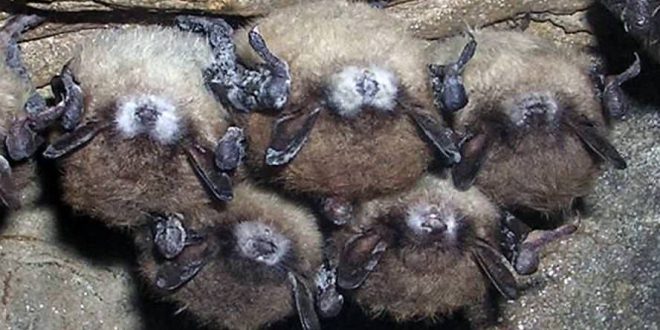The search continues for white nose syndrome, a fungal disease responsible for the deaths of millions of bats in eastern North America.
Nebraska wildlife officials announced that following the recent discovery of several dozen dead bats at a mine in Cass County, the U.S. Geological Survey’s National Wildlife Health Center in Madison, Wisconsin confirmed white-nose syndrome in three bats from the mine.
“The spread of this disease to places like Nebraska — and as far west as Washington — should ring alarm bells across the U.S.,” said Mollie Matteson, a senior scientist with the Center for Biological Diversity. “White-nose syndrome has already killed millions of bats. Land managers in the West need to work now to stop it from spreading farther, before it’s too late.”
The bat disease has afflicted seven bat species so far. Last year it was discovered in the West for the first time, when a little brown bat killed by white-nose syndrome was found near Seattle, Wash. With white-nose now confirmed in Nebraska, bats in the western United States are being hemmed in on two sides by the advancing lines of the disease. Bat species not found in the eastern half of the country may soon be newly exposed to it, and scientists do not know how they will fare.
Scientists have estimated the economic value of insect-eating bats to American agriculture at $22 billion annually. Bats also eat tons of insects harmful to forests, and their guano is essential to the survival of extremely rare cave organisms like cave salamanders and fish.
Many leading bat biologists have emphasized precautionary measures, such as cave closures and site-specific caving gear requirements, as the best management response. The Center filed a petition in 2010 to close all caves and abandoned mines on federally controlled lands in the lower 48 states, keeping all but essential human activity out of caves. Such closures also would reduce disturbance of vulnerable hibernating or roosting bats.
The disease-causing fungus, which is an exotic, invasive species likely originally brought to North America from Europe more than a decade ago, was first found in eastern Nebraska in 2015. The discovery of the disease two years later follows a now well-established pattern in which the fungus appears at bat wintering sites a few years before bats actually become sickened and die. The disease was first observed in North America in a cave near Albany, N.Y. in 2006. It has since spread throughout the eastern, southern and midwestern states and into five Canadian provinces.
White-nose syndrome has resulted in dramatic declines among several bat species. The disease has caused mortality rates ranging up to 100 percent among bats in affected caves. The northern long-eared bat, tricolored bat, little brown bat and Indiana bat are the hardest-hit species. The U.S. Fish and Wildlife Service listed the northern long-eared bat as a threatened species in 2015, primarily because of the ravages of the disease. The Service is currently considering protecting the tricolored bat and the little brown bat, both of which have also drastically declined. The Indiana bat was listed as endangered decades prior to the arrival of white-nose syndrome, but the bat disease has exacerbated its tenuous hold on survival.
White-nose syndrome is passed from one bat to another, or from the cave environment to bats, but it also likely spreads when people inadvertently carry it from one cave to another on their shoes, clothes or equipment.
Agencies/Canadajournal
 Canada Journal – News of the World Articles and videos to bring you the biggest Canadian news stories from across the country every day
Canada Journal – News of the World Articles and videos to bring you the biggest Canadian news stories from across the country every day



